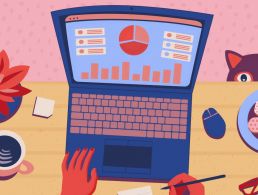Knime’s Rosaria Silipo shares how she became interested in data science, and why learning and creativity are crucial in this field.
Rosaria Silipo has been working at Knime, a software company that provides access to advanced data science and analytics, since 2013. Her love for working with data began much earlier than this, with a passion for maths and “getting results” from a young age.
“I love math, I always did,” she says. “Data science is one discipline where math is prominent. On the other side, I love to get results. There is nothing better than watching your creation at work. And data science is practical enough to produce applications that then produce results.
“Despite having done other jobs from time to time, eventually I was always drawn to data science and data analysis projects – likely because of these two complimentary features.”
The road to data science evangelist
Now as principal data scientist and head of data science evangelism at Zurich-headquartered Knime, Silipo’s working day is a combination of hammering out technical solutions, mastering communication and drawing on creativity.
In her ‘data science evangelist’ role, she strives to help people access, understand and engage with data science on a deeper level. She leads an evangelism group at Knime that explores new data science solutions and machine learning algorithms, pre-digests them, and then spreads the knowledge around.
Silipo’s journey to data science began with studying electrical engineering and completing a thesis on data analysis and neural networks. From there she completed postgraduate degrees, including a PhD in bioengineering.
She describes her career path as a “natural evolution”, but it wasn’t without its challenges. One of these has been the constant learning she has had to commit to and help others with as a data professional.
“I learned that the most important thing is that you understand the math behind the programming,” she says. “But as a data scientist, we never stop learning. I’ve been around a long time, and we’ve learned so much in just the last two years. The knowledge gets old quickly.
“One of the biggest challenges in our job is to stay up to date with the latest developments. As the head of the group, another challenge is to make sure that the whole group, from the junior to the senior employees, owns the whole baggage of technical classic knowledge.
“We are all a bit specialised, of course, but we should all have a minimum general knowledge of all data science techniques. Those are challenges common to all data scientists.”
Rosaria Silipo. Image: Knime
The other big challenge Silipo faced was being a woman in a male-dominated industry. She says it was sometimes “complicated to be accepted” and to balance working with motherhood.
“As a woman in data science, I have had to fight a few times to push forward an idea,” she explains. “There used to be a negative perception of women assertively insisting for an idea or refusing a project because it was ill-conditioned given the constraints introduced by the customer.
“Fortunately, things have changed a bit since then. It is easier now because of the past successful projects that have established my reputation as a serious professional and because of the changed perception of women in the professional world. Now our group is about 50-50 male and female. There is still some way to go, though.”
A day in the working life
In Silipo’s current role, a typical project has a number of phases. “A lot of our job is technical, in the sense that we have to produce solutions for a number of use cases, but it also involves a lot of communications,” she explains. “Communications means public presentations, lectures, courses and quite some writing like blog posts, articles or sometimes even books.”
As part of her work as a data science evangelist, Silipo recently published her ninth book, Codeless Deep Learning with Knime, which she co-authored with her colleague Kathrin Melcher.
“So, depending on the phase of the project we are currently working on, the day will see development of data science solutions, training of models like neural networks, deployment of previously trained models and then writing, correcting, posting, presenting,” she adds.
“So, the day starts with turning on the laptop, if it was not already on because it has been crunching data all night. I check the results and based on the quality of the results, I decide on whether to run a new experiment. While running the new experiment, I start correcting and refining past work.”
Typically among these tasks are meetings to discuss the status of projects and new ideas, as well as ‘evangelism’ events so the team can educate itself on the latest techniques and best practices.
The misconception around creativity
One of the things Silipo enjoys most about her job is also the biggest misconception about the field, in her eyes.
“Now I am going to say something that is quite against the common perception of this job,” she says. “The creativity I need to make use of every day is the best thing in our job. Yes, the creativity.”
She compares starting a new project and trying to “envision a possible solution” to staring at the blank page of a book you’re writing.
“In this phase there is nothing wrong; you can let your creativity run free, experiment, study what others have done with similar problems, collect specifications, check the data, and then finally – based on all the constraints and on your knowledge and ideas – you can start putting together a few solutions.”
‘People think it’s just about math, but sometimes you get challenging problems and you need to be very creative’
– ROSARIA SILIPO
The vast number of technical tools available to data scientists, she continues, allows for plenty of exploration. Teams can enjoy a period of trial and error to figure out which one is right for the problem at hand, whether it’s a true data project or more of a business case.
“[People] think it’s just about math,” she says. “But sometimes you get challenging problems and you need to be very creative and come up with different solutions. In the end, you need to tell a story and explain the numbers.”
‘Don’t be discouraged’
Based on her own career journey, Silipo has some words of wisdom for women setting out to become data scientists.
“Over the last few years I have hired a number of women in data science positions in my group,” she says. “Some women have come with the idea that the world of the technical industry would be fair, some have already come with some disappointment behind them.
“This last group is – or at least has been – asking often about advice on how to most successfully stay and advance in a data science career. I often give one [piece of] advice: keep an open attitude. Despite what people might think, there is not anybody who knows everything in this field. Learn as much as you can from books, blog posts, courses, colleagues and previous projects, and then keep learning throughout your whole career.
“Keep being curious and keep learning about new technology, new algorithms, new solutions, the work of others. Our field is constantly changing; new uses and new techniques pop up every day. Keeping the interest and the curiosity high means to keep up with the technological evolution. I am still learning myself!
“And learn from your colleagues, not just books. Keep your curiosity up. For women in particular, be more assertive. And don’t be discouraged.”




